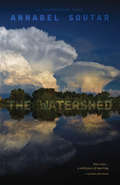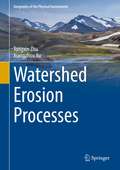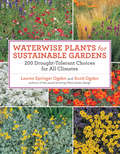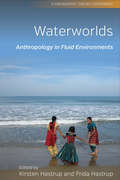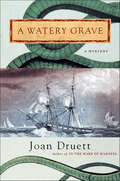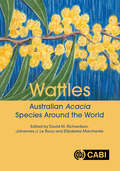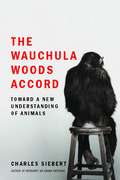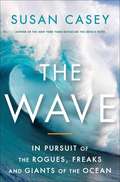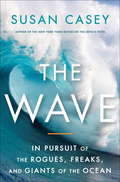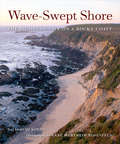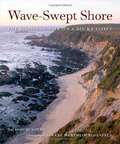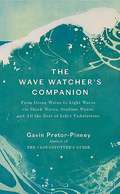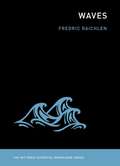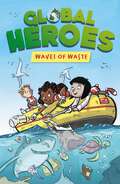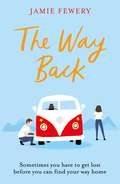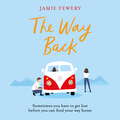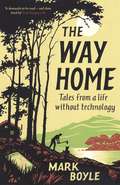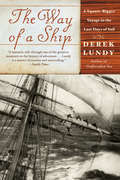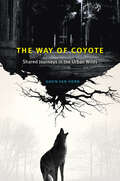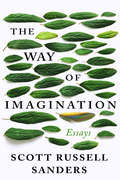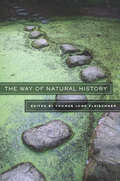- Table View
- List View
The Watershed
by Annabel SoutarHow much do we value clean water? Enough to stop our industrialized way of life from degrading it? The documentary play The Watershed follows an artist and her family in the struggle to chart a sustainable course between economic prosperity and environmental stewardship. Annabel Soutar is Canada's foremost documentary theater writer.
Watershed Erosion Processes (Geography of the Physical Environment)
by Tongxin Zhu Xiangzhou XuThis monograph is a fundamental study of watershed erosion and runoff processes. It utilizes decades of soil erosion data to take a comprehensive and balanced approach in covering various watershed erosion processes. While there are many works on soil erosion and conservation, this book fills the gaps in previously published research by focusing more on mass movement, gully erosion, soil piping/tunnel erosion, and the spatial interactions of different erosion processes. Additionally, the book examines erosion processes in extreme rainfall events, something typically absent in short-term studies but discussed in detail here as the book draws on 60 years of research and observations, including 30 years of the author's own investigations of erosion under a wide range of rainfall conditions. The book is divided into 3 parts, and is intended for soil erosion researchers and practitioners, and postgraduate students studying soil erosion and water conservation. Part 1 opens with a comprehensive and critical review of existing literature on soil erosion processes, discusses this book's place among existing literature, and examines the major erosion processes (rainwash, gully erosion, tunnel erosion, and mass movements) including their controlling factors and mechanisms. Part 2 explores the spatial interactions of these different erosion processes to provide a prerequisite for effective design of comprehensive soil erosion control measures in a watershed. Part 3 evaluates the relative significance of these erosion processes in sediment production, the effectiveness of comprehensive soil and water conservation programs, and the applications of watershed modelling in determining the impact of land-use changes on soil erosion and other ecological processes.
A Watershed Runs Through You: Essay, Talks, and Reflections on Salmon, Restoration, and Community
by Freeman HouseThis anthology brings together a selection of essays, articles, and lectures that represent the work of environmentalist Freeman House, whose work built the involvement of local citizens in the restoration of watersheds in northern California. "Consequences flow downstream," he points out, "and we're all in their path." While much of House's work focuses on the restoration of wild salmon populations, he shows how all life is connected and interdependent. His restoration efforts in the Mattole Watershed contain blueprints for restoration efforts everywhere.
Waterwise Plants for Sustainable Gardens: 200 Drought-Tolerant Choices for all Climates
by Scott Ogden Lauren Springer Ogden“I can't imagine a designer or avid gardener who wouldn't want this on their bookshelf.” —Garden Design OnlineWaterwise Plants for Sustainable Gardens is a practical guide to the best 200 plants guaranteed to thrive in low-water gardens. Plant entries provide the common and botanical name, the regions where the plant is best adapted, growth and care information, and notes on pests and disease. This practical and inspiring guide includes a variety of plants, from trees to succulents, perennials to bulbs, all selected for their wide adaptability and ornamental value. Companion plants, creative design ideas, and full color photography make this guide a must-have resource for any sustainable gardener.
Waterworlds: Anthropology in Fluid Environments
by Kirsten Hastrup Frida HastrupIn one form or another, water participates in the making and unmaking of people's lives, practices, and stories. Contributors' detailed ethnographic work analyzes the union and mutual shaping of water and social lives. This volume discusses current ecological disturbances and engages in a world where unbounded relationalities and unsettled frames of orientation mark the lives of all, anthropologists included. Water emerges as a fluid object in more senses than one, challenging anthropologists to foreground the mutable character of their objects of study and to responsibly engage with the generative role of cultural analysis.
A Watery Grave: A Mystery (Wiki Coffin Mysteries #1)
by Joan DruettThe year is 1838, and after more than ten years in the planning, the famous United States Exploring Expedition is set to launch into uncharted waters from the coast of Virginia. A convoy of seven ships filled with astronomers, mapmakers, naturalists, and the sailors charged with getting them around the world, the "Ex. Ex." is finally underway, with much fanfare.Aboard the convoy as ship's linguist is Wiki Coffin. Half New Zealand Maori and half American, Wiki speaks numerous languages and is expected to help the crew navigate the Pacific islands that are his native heritage. But just before departure Wiki, subject to the unfortunate bigotry of the time, is arrested for a vicious murder he didn't commit.The convoy sails off, but just before the ships are out of reach Wiki is exonerated, set free to catch up with his ship and sail on. The catch: the local sheriff is convinced that the real murderer is aboard one of the seven ships of the expedition, and Wiki is deputized to identify the killer and bring him to justice. Full of the evocative maritime detail and atmosphere that have won her numerous awards for her nonfiction, Joan Druett's A Watery Grave is the mystery debut of a masterful maritime writer.
Watery Planet: How a water crisis is impacting our world
by Anna ClaybourneWatery Planet offers young readers a clear, insightful look at Earth's ongoing water challenges.Water makes our life on Earth possible. We need water not just to drink and keep clean, but also for agriculture, industry, transport and much, much more. But despite having an enormous amount of water on Earth, only 1 per cent of it is available for us to use and it's at increasing risk.Watery Planet looks at the reasons behind our looming water crisis - from uneven distribution to water wastage, pollution and climate change. It explores how floods, droughts and rising sea levels are becoming a stark reality as the world warms and describes how we are adapting to these challenges. It also looks at some positive, practical solutions to our water problems and explains how we can all do our part to help save Earth's most precious resource.Contents:A WHOLE WORLD OF WATER WE ALL NEED WATER! HOW WE GET WATER IS THERE ENOUGH WATER? WATER AND HEALTH CASE STUDY: COLLECTING WATER IN ETHIOPIA WATER POLLUTION WATER AND GLOBAL WARMING FLOODS AND DROUGHTS CASE STUDY: PAKISTAN FLOODS RISING SEA LEVELS WATER AND NATURE WATER AND WILDLIFE CASE STUDY: THIRSTY AVOCADOS DOING THINGS DIFFERENTLY WATER FOR THE WORLD CASE STUDY: THE ARAL SEA WATERY HOMES WHAT CAN YOU DO? THE FUTURE OF WATER GLOSSARY FURTHER READING INDEX Titles in this series:Plastic PlanetHot PlanetRecycled PlanetSustainable PlanetExtinction PlanetPeaceful Planet?Unequal Planet
Wattles: Australian Acacia Species Around the World
by Narciso Aguilera Joaquim Alonso Samuel C. Andrew Irene Barnes Ashleigh M. Basel Rita Bastos Pierre Binggeli Rachel M. Binks Christophe Botella Giuseppe Brundu David Bush Dr Margaret Byrne João A. Cabral Jane Carruthers Laura Celesti-Grapow Julian M. Chan Roland Cochard M. Conceição Colaço Peter J. Cunningham Jorge Dias Catherine R. Dickson Liliana N. Duarte Allan G. Ellis Luís Fernandes Nuno Fernandes Eduardo Fuentes-Lillo Andrés Fuentes-Ramírez Rachael V. Gallagher Rafael García Sjirk Geerts Michelle R. Gibson Margherita Gioria Catarina Gonçalves João Gonçalves Vinicius Paiva Gonçalves Pablo González-Moreno Luís González António Carmo Gouveia A. Rod Griffin André Große-Stoltenberg Greg R. Guerin Antoine Guisan Stuart Hall Jane L. Harbard Gustavo Heringer Richard Hill Patricia M. Holmes João P. Honrado Cang Hui Philip E. Hulme Brett P. Hurley Fiona Impson Cally Jansen Nolwethu Jubase-Tshali Jan-Hendrik Keet Rob Kelly Ian Kotze Christoph Kueffer Ingolf Kühn Dr Christian A. Kull Sabrina Kumschick Vitalis K. Lagat Bárbara Langdon Guillaume Latombe David C. Le Maitre Ivan Lizarazo Francisco López-Núñez Paula Lorenzo Vanessa Lozano Sérgio Maggiolli Cristina Máguas Hélia Marchante Irene Martín-Forés Cecilia Masemola Bruce Maslin David J. Merritt Stephen J. Midgley Melissa A. Millar Carey Minteer Leonie T. Monks Nuno Mouta Jana Mullerova Daniel J. Murphy Silvia Neves Dung Tri Ngo Dr Ana Novoa Jens Oldeland Lucas Prado Osco Penelope P. Pascoe Dr Aníbal Pauchard Thao Phuong Pham Eva M. Pinto Petr Pyšek Jorge E. Ramirez-Albores A. Tony Rinaudo Matt Ritter Libby Robin James G. Rodger Philip W. Rundel Mário Santos Charlie Shackleton Dr Ross Shackleton Iryna Skulska Canh Quoc Tran Thang Nam Tran Helena Trindade Florian Ulm Van Thi Hai Dr Brian Van Wilgen Maribel Vásquez-Valderrama A. Sofia Vaz Joana R. Vicente Sara Vicente Elizabeth M. Wandrag Andrew Wannenburgh Christiane Werner John R. Wilson Michael Wingfield Rafael Dudeque ZenniThe book provides a comprehensive overview of current knowledge about "wattles", a large clade of over 1000 species of trees and shrubs in the genus Acacia, most of which are native to Australia. It examines the biology, ecology, evolution, and biogeography of wattles in their native ranges, including the evolutionary forces that have driven past speciation and adaptation to diverse environments, the conservation status, uses and human perceptions of these species. It considers the different histories of the introductions and proliferation of wattles as alien species in different parts of the world since c. 1850 (the Anthropocene), situated within relevant political, socio-economic and scientific contexts, together with an analysis of how awareness of their impacts as invasive species has changed over time. Differences in the dynamics and trends associated with the introduction, naturalization and invasion of wattles in different parts of the world are reviewed. The book also synthesizes the global distribution of wattles using diverse data sources, alongside trends, patterns and projections of global uses of wattles. It discusses the genetics, biotic interactions, and ecological, economic and social impacts of invasive wattles. - The first comprehensive global synthesis in book form of aspects of the biology, ecology, biogeography and management of one of the world's most important woody plant genera. - Provides the foundation for the assessment of evidence-based information required to formulate sustainable management strategies for non-native plants that have both benefits and negative impacts. - Sheds new light on many aspects of plant invasion science. This book is aimed at academics and students in the field of ecology, and at managers of natural and anthropic ecosystems, policy-makers and regulators, and the general public interested in biology and environmental science.
The Wauchula Woods Accord
by Charles Siebert"WHILE TRAVELING AROUND THE COUNTRY to report on the conditions in which captive chimpanzees in America live, Charles Siebert visited a retirement home for former ape movie stars and circus entertainers in Wauchula, Florida, known as the Center for Great Apes. There Siebert encountered Roger, a twenty-eight-year-old former Ringling Bros. star who not only preferred the company of people to that of his fellow chimps but seemed utterly convinced that he knew the author from some other time and place. ""Mostly I was struck by Roger's stare,"" writes Siebert, ""his deep-set hazel eyes peering out at me with what, to my deep discomfort, I'd soon realize is their unchanging expression. It is a beguiling mix of amazement and apprehension, the look, as I've often thought of it since, of a being stranded between his former self and the one we humans have long been suggesting to him. A sort of hybrid of a chimp and a person. A veritable 'humanzee.
The Wave: In Pursuit of the Rogues, Freaks and Giants of the Ocean
by Susan CaseyFrom Susan Casey, bestselling author of The Devil's Teeth, an astonishing book about colossal, ship-swallowing rogue waves and the surfers who seek them out. For centuries, mariners have spun tales of gargantuan waves, 100-feet high or taller. Until recently scientists dismissed these stories--waves that high would seem to violate the laws of physics. But in the past few decades, as a startling number of ships vanished and new evidence has emerged, oceanographers realized something scary was brewing in the planet's waters. They found their proof in February 2000, when a British research vessel was trapped in a vortex of impossibly mammoth waves in the North Sea--including several that approached 100 feet. As scientists scramble to understand this phenomenon, others view the giant waves as the ultimate challenge. There are extreme surfers who fly around the world trying to ride the ocean's most destructive monsters. The pioneer of extreme surfing is the legendary Laird Hamilton, who, with a group of friends in Hawaii, figured out how to board suicidally large waves of 70 and 80 feet. Casey follows this unique tribe of people as they seek to conquer the holy grail of their sport, a 100-foot wave. In this mesmerizing account, the exploits of Hamilton and his fellow surfers are juxtaposed against scientists' urgent efforts to understand the destructive powers of waves--from the tsunami that wiped out 250,000 people in the Pacific in 2004 to the 1,740-foot-wave that recently leveled part of the Alaskan coast. Like Jon Krakauer's Into Thin Air, The Wave brilliantly portrays human beings confronting nature at its most ferocious.
The Wave: In Pursuit of the Rogues, Freaks and Giants of the Ocean
by Susan CaseyFrom Susan Casey, bestselling author of The Devil's Teeth, an astonishing book about colossal, ship-swallowing rogue waves and the surfers who seek them out. For centuries, mariners have spun tales of gargantuan waves, 100-feet high or taller. Until recently scientists dismissed these stories--waves that high would seem to violate the laws of physics. But in the past few decades, as a startling number of ships vanished and new evidence has emerged, oceanographers realized something scary was brewing in the planet's waters. They found their proof in February 2000, when a British research vessel was trapped in a vortex of impossibly mammoth waves in the North Sea--including several that approached 100 feet.As scientists scramble to understand this phenomenon, others view the giant waves as the ultimate challenge. These are extreme surfers who fly around the world trying to ride the ocean's most destructive monsters. The pioneer of extreme surfing is the legendary Laird Hamilton, who, with a group of friends in Hawaii, figured out how to board suicidally large waves of 70 and 80 feet. Casey follows this unique tribe of people as they seek to conquer the holy grail of their sport, a 100-foot wave.In this mesmerizing account, the exploits of Hamilton and his fellow surfers are juxtaposed against scientists' urgent efforts to understand the destructive powers of waves--from the tsunami that wiped out 250,000 people in the Pacific in 2004 to the 1,740-foot-wave that recently leveled part of the Alaskan coast.Like Jon Krakauer's Into Thin Air, The Wave brilliantly portrays human beings confronting nature at its most ferocious.
Wave-Swept Shore: The Rigors of Life on a Rocky Coast
by Dr. Mimi A. KoehlTake a close look at a wave-battered coast and you will discover a rich, fascinating, and remarkably brutal environment. Here, animals and plants exposed to wind, sun, and rain at low tide must cope with crashing waves as the seas rise to submerge them each day at high tide. How do living things survive in this harsh zone? With 87 stunning color photographs and an engaging text written for those with little or no knowledge of marine biology or physics, this book tells the story of one stretch along the Pacific coast of North America—introducing the mussels, limpets, crabs, grasses, starfish, kelp, and other animals and plants that live there, and explaining how they function and flourish in an environment of waves, sand, and rocks.In pictures and words, Wave-Swept Shore explains complex phenomena, such as wave action, using simple, intuitive analogies. It explores how the forms of animals and plants affect their survival in this harsh environment, considers their distribution on the shore, and looks at their seasonal variations, focusing on what can be easily observed by visitors to the coast. Revealing the rich variety of habitats woven into what may at first look like a fairly uniform environment, the book, an effective and beautiful tool for learning about the edge of oceans everywhere, opens our eyes to the wonders of rocky shores and introduces a whole new way of looking at the natural world.
Wave-Swept Shore: The Rigors of Life on a Rocky Coast
by Mimi KoehlThis book tells the story of one stretch along the Pacific coast of North America--introducing the mussels, limpets, crabs, grasses, starfish, kelp, and other animals and plants that live there, and explaining how they function and flourish in an environment of waves, sand, and rocks.
The Wave Watcher's Companion
by Pretor-Pinney GavinA lively, revealing look at waves of all kinds from the bestselling author of The Cloudspotter's Guide Get ready for a global journey like no other-a passionate enthusiast's exploration of waves that begins with a quiet afternoon at the shore and ends with the world-class Hawaiian surf, making side trips to reveal the ups and downs of brain waves, radio waves, infrared waves, microwaves, shock waves, light waves, and much more. .
Waves
by Fredric RaichlenSitting on the beach on a sunny summer day, we enjoy the steady advance and retreat of the waves. In the water, enthusiastic waders jump and shriek with pleasure when a wave hits them. But where do these waves come from? How are they formed and why do they break on the shore? In Waves, Fredric Raichlen traces the evolution of waves, from their generation in the deep ocean to their effects on the coast. He explains, in a way that is readily understandable to nonscientists, both the science of waves themselves and the technology that can be used to protect us against their more extreme forms, including hurricanes and tsunamis. After offering a basic definition of waves and explaining the mechanics of wind-wave generation, Raichlen describes how waves travel, how they shoal (rise), how they break, and how they transform in other ways. He goes on to describe, among other things, the complicated sun-Earth-moon combinations that create astronomical tides (the high and low tides that occur daily and predictably); the effects of waves on the beach, including rip currents and beach erosion, and on harbors and shipping; and the building of breakwaters to protect harbors and bays. He discusses hurricanes, storm surges, and hurricane-generated waves. He offers a brief history of tsunamis, including Sumatra's in 2004 and Japan's in 2011, and explains the mechanisms that generate them (including earthquakes, landslides, and volcanoes). Waves can be little ripples that lap peacefully at the shore or monstrous tsunamis that destroy everything in their paths. Describing the science underlying this astonishing variety, Waves offers a different kind of beach reading.
Waves of Waste (Global Heroes #1)
by Damian HarveyJoin our team of Global Heroes in this fast-paced, science-themed chapter book as they aim to rid the seas of the rising pollution and waste, but must also navigate deadly dangers from sea predators... Great for readers age 7+ these adventure stories are also full of fascinating facts. These illustrated chapter books are perfect for making fascinating science topics accessible to young readers, inspiring a thirst for knowledge and learning by stealth. The team of characters come from around the world to give a truly global outlook.
The Way Back: The funny, insightful and hopeful family adventure you need in 2021
by Jamie FeweryA moving, funny, sweeping and emotional family drama perfect for fans of David Nicholls, Beth O'Leary, Mike Gayle and Caroline Hulse.* * * * * * *If you're reading this, my funeral must have just finished. I've got something to ask of you...Who knows, you might even enjoy it?The Cadogan children haven't spoken to each other for three years. But their father, Gerry, has a plan to bring them together. To scatter his ashes, they must first drive his old camper van up to Scotland...For the trip, Gerry has provided them with three family photo albums and a bottle of single malt whisky.But will the journey help banish their ghosts and turn them back into a family? Or will it show them exactly why they've stayed apart for so long?* * * * * * *Praise for Jamie Fewery:'Moving, honest, sad and hopeful' MIRANDA DICKINSON'Will melt your heart' VERONICA HENRY'Clever, moving, funny, insightful' ZOE FOLBIGG'Made me do a proper ugly cry' DOMESTIC SLUTTERY
The Way Back: The funny, insightful and hopeful family adventure you need in 2021
by Jamie FeweryA moving, funny, sweeping and emotional family drama perfect for fans of David Nicholls, Beth O'Leary, Mike Gayle and Caroline Hulse.* * * * * * *If you're reading this, my funeral must have just finished. I've got something to ask of you...Who knows, you might even enjoy it?The Cadogan children haven't spoken to each other for three years. But their father, Gerry, has a plan to bring them together. To scatter his ashes, they must first drive his old camper van up to Scotland...For the trip, Gerry has provided them with three family photo albums and a bottle of single malt whisky.But will the journey help banish their ghosts and turn them back into a family? Or will it show them exactly why they've stayed apart for so long?* * * * * * *Praise for Jamie Fewery:'Moving, honest, sad and hopeful' MIRANDA DICKINSON'Will melt your heart' VERONICA HENRY'Clever, moving, funny, insightful' ZOE FOLBIGG'Made me do a proper ugly cry'DOMESTIC SLUTTERY
The Way Back: The funny, insightful and hopeful family adventure you need in 2021
by Jamie FeweryA moving, funny, sweeping and emotional family drama perfect for fans of David Nicholls, Beth O'Leary, Mike Gayle and Caroline Hulse.* * * * * * *If you're reading this, my funeral must have just finished. I've got something to ask of you...Who knows, you might even enjoy it?The Cadogan children haven't spoken to each other for three years. But their father, Gerry, has a plan to bring them together. To scatter his ashes, they must first drive his old camper van up to Scotland...For the trip, Gerry has provided them with three family photo albums and a bottle of single malt whisky.But will the journey help banish their ghosts and turn them back into a family? Or will it show them exactly why they've stayed apart for so long?* * * * * * *Praise for Jamie Fewery:'Moving, honest, sad and hopeful' MIRANDA DICKINSON'Will melt your heart' VERONICA HENRY'Clever, moving, funny, insightful' ZOE FOLBIGG'Made me do a proper ugly cry' DOMESTIC SLUTTERY
The Way Home: Tales from a Life Without Technology
by Mark BoyleIt was 11pm when I checked my email for the last time and turned off my phone for what I hoped would be forever. No running water, no car, no electricity or any of the things it powers: the internet, phone, washing machine, radio or light bulb. Just a wooden cabin, on a smallholding, by the edge of a stand of spruce. In this honest and lyrical account of a remarkable life without modern technology, Mark Boyle explores the hard won joys of building a home with his bare hands, learning to make fire, collecting water from the spring, foraging and fishing. What he finds is an elemental life, one governed by the rhythms of the sun and seasons, where life and death dance in a primal landscape of blood, wood, muck, water, and fire – much the same life we have lived for most of our time on earth. Revisiting it brings a deep insight into what it means to be human at a time when the boundaries between man and machine are blurring.
The Way of a Ship
by Derek LundyFrom the author of Godforsaken Sea -- a #1 bestseller in Canada and "one of the best books ever written about sailing" (Time magazine) -- comes a magnificent re-creation of a square-rigger voyage round Cape Horn at the end of the 19th century.In The Way of a Ship, Derek Lundy places his seafaring great-great uncle, Benjamin Lundy, on board the Beara Head and brings to life the ship's community as it performs the exhausting and dangerous work of sailing a square-rigger across the sea.The "beautiful, widow-making, deep-sea" sailing ships could sail fast in almost all weather and carry substantial cargo. Handling square-riggers demanded detailed and specialized skills, and life at sea, although romanticized by sea-voyage chroniclers, was often brutal. Seamen were sleep deprived and malnourished, at times half-starved, and scurvy was still a possibility. Derek Lundy reminds readers what Melville and Conrad expressed so well: that the sea voyage is an overarching metaphor for life itself. As Benjamin Lundy nears the Horn and its attendant terrors, the traditional qualities of the sailor -- fatalism, stoicism, courage, obedience to a strict hierarchy, even sentimentality -- are revealed in their dying days, as sail gave way to steam.Derek Lundy tells his gripping tale with the kind of storytelling skill and writerly breadth that is usually the ken of our finest novelists, and in so doing, imagines a harrowing and wholly credible history for his seafaring Irish-Canadian ancestor.From the Trade Paperback edition.
The Way of Coyote: Shared Journeys in the Urban Wilds
by Gavin Van HornA hiking trail through majestic mountains. A raw, unpeopled wilderness stretching as far as the eye can see. These are the settings we associate with our most famous books about nature. But Gavin Van Horn isn’t most nature writers. He lives and works not in some perfectly remote cabin in the woods but in a city—a big city. And that city has offered him something even more valuable than solitude: a window onto the surprising attractiveness of cities to animals. What was once in his mind essentially a nature-free blank slate turns out to actually be a bustling place where millions of wild things roam. He came to realize that our own paths are crisscrossed by the tracks and flyways of endangered black-crowned night herons, Cooper’s hawks, brown bats, coyotes, opossums, white-tailed deer, and many others who thread their lives ably through our own. With The Way of Coyote, Gavin Van Horn reveals the stupendous diversity of species that can flourish in urban landscapes like Chicago. That isn’t to say city living is without its challenges. Chicago has been altered dramatically over a relatively short timespan—its soils covered by concrete, its wetlands drained and refilled, its river diverted and made to flow in the opposite direction. The stories in The Way of Coyote occasionally lament lost abundance, but they also point toward incredible adaptability and resilience, such as that displayed by beavers plying the waters of human-constructed canals or peregrine falcons raising their young atop towering skyscrapers. Van Horn populates his stories with a remarkable range of urban wildlife and probes the philosophical and religious dimensions of what it means to coexist, drawing frequently from the wisdom of three unconventional guides—wildlife ecologist Aldo Leopold, Taoist philosopher Lao Tzu, and the North American trickster figure Coyote. Ultimately, Van Horn sees vast potential for a more vibrant collective of ecological citizens as we take our cues from landscapes past and present. Part urban nature travelogue, part philosophical reflection on the role wildlife can play in waking us to a shared sense of place and fate, The Way of Coyote is a deeply personal journey that questions how we might best reconcile our own needs with the needs of other creatures in our shared urban habitats.
The Way of Imagination: Essays
by Scott Russell SandersPrize–winning essayist turns to the imagination as a spiritual guide and material method of living through climate disruption, as climate change and broad extinction forever alter our place on the planet and our lives together.Scott Russell Sanders shows how imagination, linked to compassion, can help us solve the urgent ecological and social challenges we face. While reflecting on the conditions needed for human flourishing, he tells the story of his own intellectual and moral journey from childhood religion to an adult philosophy of life. That philosophy is tested when his first wife and then their son fall ill. Compelled to leave their beloved old house, they design a new one, and then transform their vision into a home and their raw city lot into a garden.
The Way of Natural History
by Thomas Lowe FleischnerIn this eclectic anthology, more than 20 scientists, nature writers, poets, and Zen practitioners, attest to how paying attention to nature can be a healing antidote to the hectic and harrying pace of our lives. Throughout this provocative and uplifting book, writers describe their various experiences in nature and portray how careful, and mindful, attention to the larger world around us brings rewarding and surprising discoveries. They give us the literary, personal, and spiritual stories that point a way toward calm and quiet for which many people today hunger. Contributors to The Way of Natural History highlight their individual ways of paying attention to nature and discuss how their experiences have enlivened and enhanced their worlds. The anthology is a rich array of writings that provide models for interacting with the natural world, and together, create a call for the importance of natural history as a discipline.
The Way of Natural History
by Thomas Lowe FleischnerIn this eclectic anthology, more than 20 scientists, nature writers, poets, and Zen practitioners, attest to how paying attention to nature can be a healing antidote to the hectic and harrying pace of our lives. Throughout this provocative and uplifting book, writers describe their various experiences in nature and portray how careful, and mindful, attention to the larger world around us brings rewarding and surprising discoveries. They give us the literary, personal, and spiritual stories that point a way toward calm and quiet for which many people today hunger. Contributors to The Way of Natural History highlight their individual ways of paying attention to nature and discuss how their experiences have enlivened and enhanced their worlds. The anthology is a rich array of writings that provide models for interacting with the natural world, and together, create a call for the importance of natural history as a discipline.
